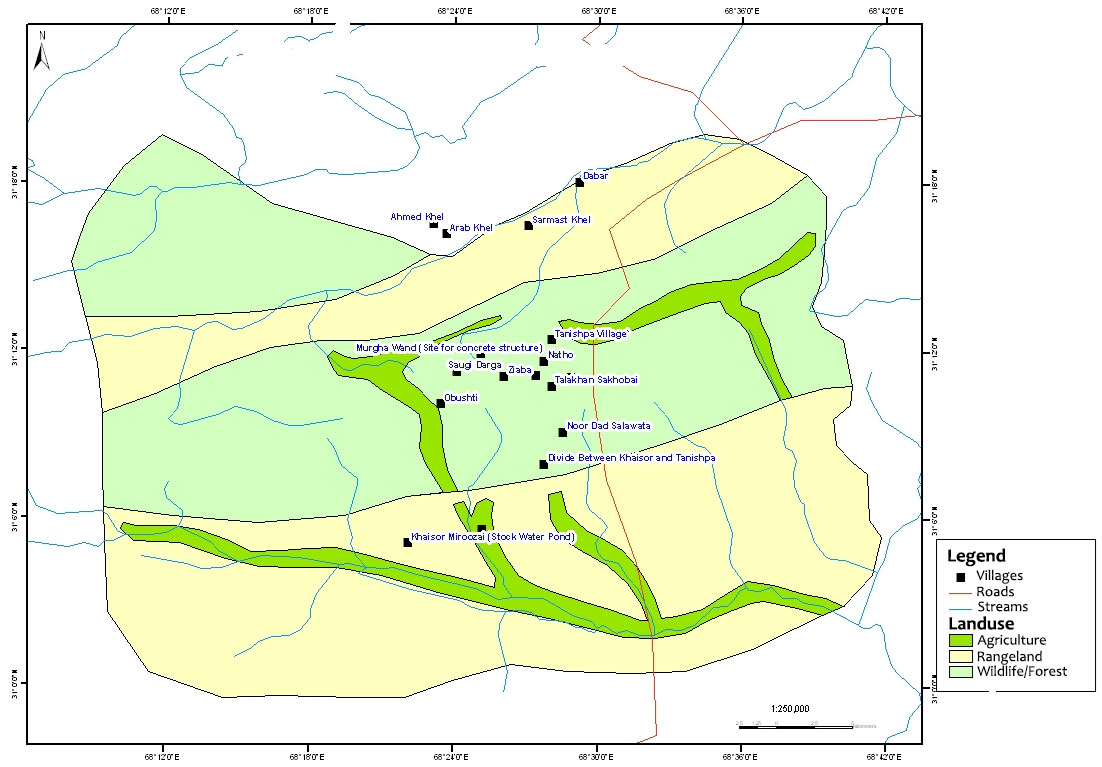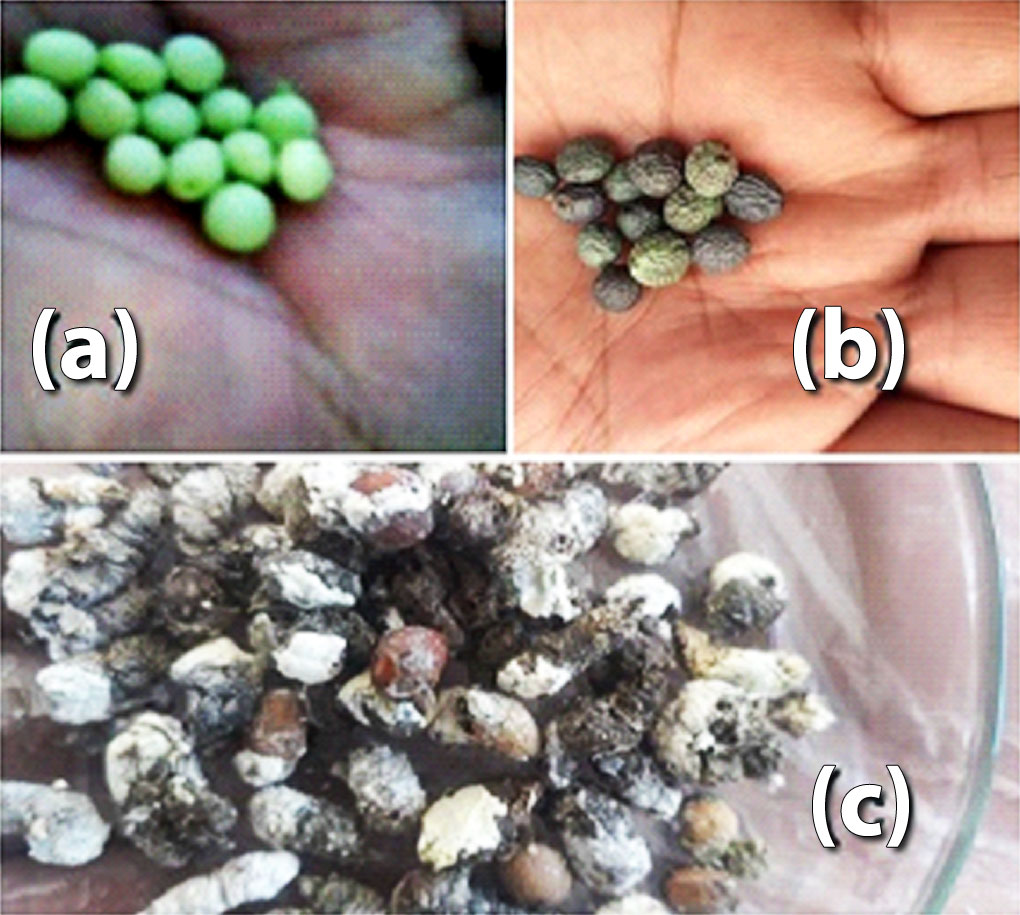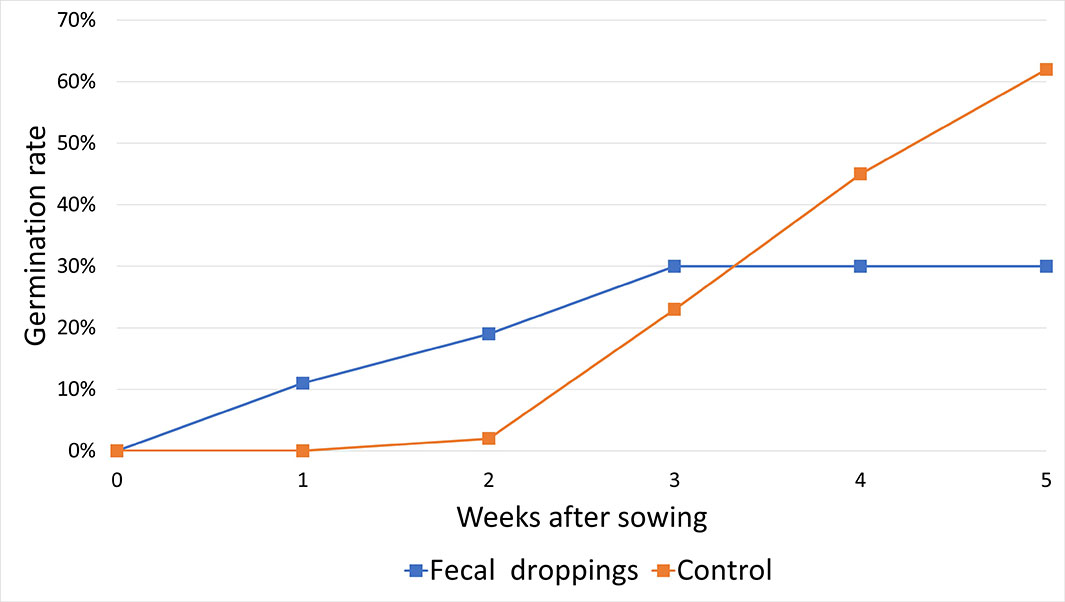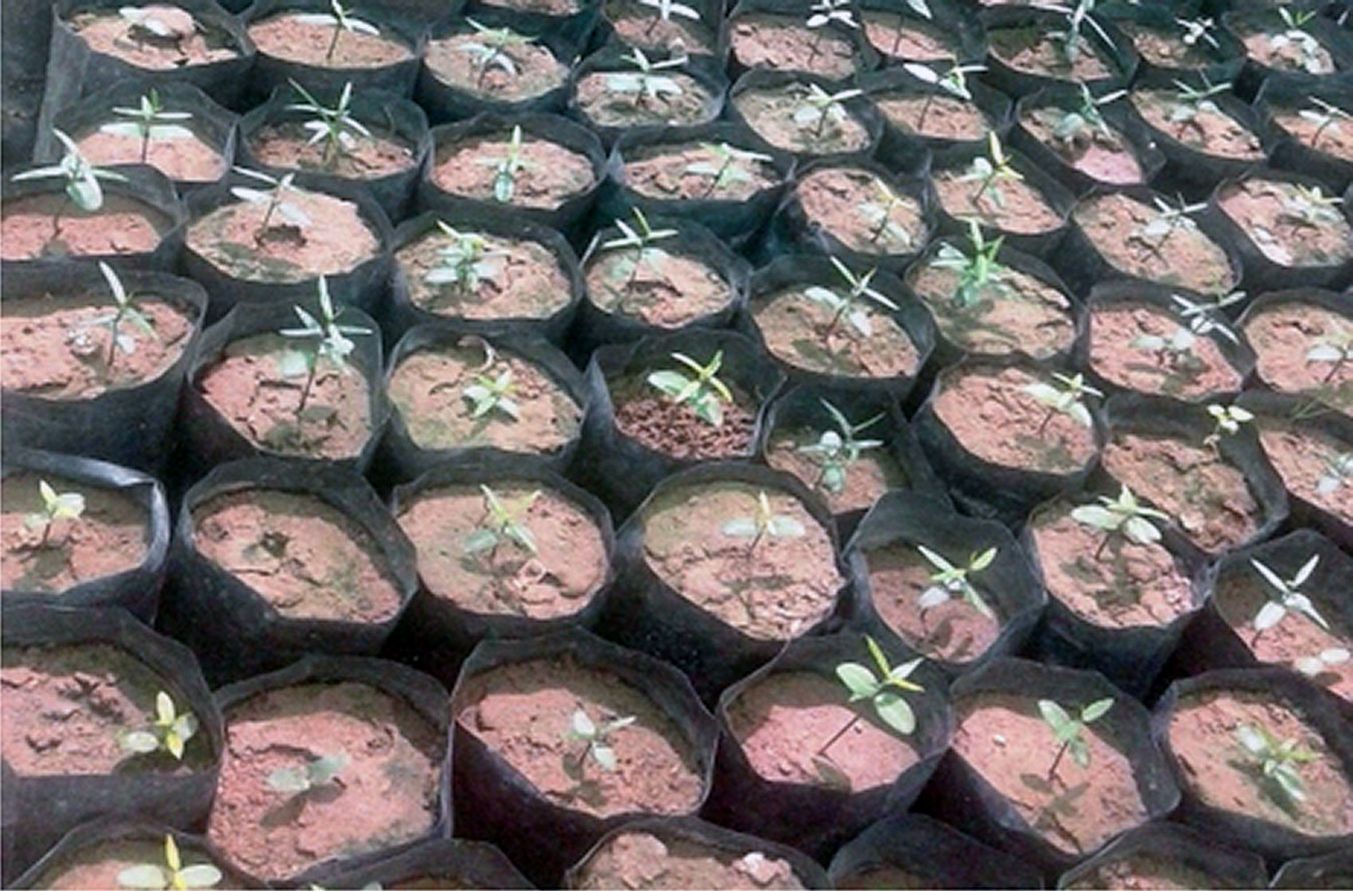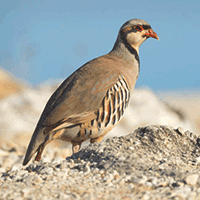
Evidence of Alectoris chukar (Aves, Galliformes) as seed dispersal and germinating agent for Pistacia khinjuk in Balochistan, Pakistan
iForest - Biogeosciences and Forestry, Volume 14, Issue 4, Pages 378-382 (2021)
doi: https://doi.org/10.3832/ifor3691-014
Published: Aug 22, 2021 - Copyright © 2021 SISEF
Short Communications
Abstract
Seed dispersal is a key process for the distribution of wild fruit plants in forests and/or rangeland. The ecological role of Alectoris chukar as a seed dispersal agent was hardly known to date, though its diet consists of herbs, shrubs, and fleshy fruits of wild plants. Here we report the first evidence of seed dispersal and germination of wild pistachio plant (Pistacia khinjuk Stocks) favored by Alectoris chukar from the district Killa Saifullah and Pishin in Balochistan, Pakistan. Fecal droppings of Alectoris chukar were collected by a suitable sampling method from August to September 2020. Fecal droppings were kept in plastic bags, and later washed thoroughly, identified, and counted for Pistacia khinjuk seeds, which have a characteristic rounded and tough seed coat easily distinguishable from other seeds. Out of a total of 840 fecal samples collected, 557 were identified as Pistacia khinjuk seeds. A comparative germination trial was carried out for pistachio seeds both from Alectoris chukar fecal droppings and manually collected from mother trees in the forest. After passing through the chukar gut, the seeds were still viable and showed a faster germination rate as compared with seeds collected from mother trees and directly sown in the soil. The results revealed that Alectoris chukar is an important spreading and germinating agent for seeds of pistachio plants in suitable habitats and could contribute in the long term to modify the ground vegetation of (sub)arid regions depending on its dietary preferences.
Keywords
Alectoris chukar, Balochistan, Fecal Dropping, Pistacia khinjuk, Seed Dispersal, Seed Germination
Introduction
Birds and trees play an important role in the natural food chain and ecosystem maintenance worldwide. Fauna and flora always co-exist in the ecosystem, prevailing on the surface of the earth ([15]). Dispersal of seeds through animals is one of the processes needed for the existence of several fleshy-fruited woody species ([18]). Seed dispersal has always counted for its effects on the ecosystem ([22]), as it could favor plant establishment in many ways: accelerating seed germination as a result of gut treatment ([7]), accelerating seedling growth rate through the provision of fecal fertilizer to the seeds ([16], [19]), deposition of seeds in high suitable sites for seed germination. For example, Apostasia nipponica (Orchidaceae) has green inconspicuous and indehiscent fruits which fully depends on cricket or camel cricket species for their seed dispersal ([13], [14]).
The chukar partridge (Alectoris chukar Gray, Phasianidae) is a common, fast-flying game bird found in rocky terrains, but it could also adapt to a variety of grasslands and open woodlands ([2]). Alectoris chukar forms conspicuous populations on high hills of Asia, the Middle East, and Western Europe ([11]). The natural range of Alectoris chukar includes the mountains of Mediterranean islands, Iran, Turkey, Russia, China, India, Nepal, and Pakistan ([2], [3]). Although chukar partridges have been introduced all over the world, there is still scarce information available regarding its home range, survival and its role as a seed dispersal agent. Chukar partridges have been widely introduced for game hunting in the United States, Canada, England, New Zealand, and Hawaii ([11]). Alectoris chukar was introduced to the USA from Balochistan, Pakistan in the year 1893 ([12]), and now a huge wild population of chukar partridges exists in the United States of America ([10]). Alectoris chukar distribution and successful adaptation in North America is considered to be linked with cheatgrass (Bromus tectorum L.) as it largely feeds on this herbaceous species, thereby favoring seed dispersal ([20]). Up to date, no fleshy fruit in the Anacardiaceae family has been reported as chukar partridge feed.
The pistachio tree (Pistacia khinjuk) is a fleshy fruit tree belonging to the Anacardiaceae family widely distributed in Pakistan, Iran, Iraq, Syria, Turkey, and Afghanistan. The pistachio tree is an extremely slow-growing species, hence it is difficult to be reared. This plant is widely used as a traditional medicinal plant for the treatment of stomach discomfort, motion sickness, nausea, anti-inflammatory, anti-oxidant, anti-tumor, anti-asthmatic, and anti-microbial activities and vomiting ([5]).
In Balochistan, a province in the South-West of Pakistan, the wild population of chukar partridges is abundant in many districts. They feed on a wide variety of grasses, fruits of woody trees. During the late summer the main diet of chukar partridges is constituted by fruits of Pistacia khinjuk.
The objective of this study was to investigate the ecological role of Alectoris chukar as seed dispersal agent for Pistacia khinjuk. We investigated whether chukar partridges disperse the seeds of Pistacia khinjuk by collecting fecal samples through a suitable collection method and whether seeds survive after the passage in the bird gut; finally, we conducted a comparative germination trial between hand-collected and fecal drop seeds.
Materials and methods
Study area
The study has been carried out at the Taghratu State Forest and Torghar (31° 12′ 28″ N 68° 26′ 29″ E - Fig. 1). Taghratu State Forest is one of the most important forest areas of the Pishin Forest Division. The total area of the State Forest is about 33.000 acres (about 13.354 ha) and reach an altitude of more than 3000 m a.s.l. Summer is hot (up to 35 °C), while winter is cold with temperature reaching -18 °C. Like other parts of the Pishin District, Taghratu lies outside of the area of monsoon currents, thus rainfall is irregular and scanty. Two types of woody trees are dominant in the study area, i.e., Pistacia khinjuk and Juniper spp. Ground vegetation is very low and scattered. Among wild birds, Alectoris chukar is the dominant species.
Torghar is the northernmost part of the Toba Kakar Range, located in the Killa Saifullah district of Balochistan, Pakistan. The altitude of this area varies from 2400 to 3300 m a.s.l. The weather is strongly variable, with hot summer season (up to 37 °C) and cold winter (as low as -14 °C). Precipitation occurs from December to March in the form of snow. Rainfall is light and variable, with an annual average of about 100-250 mm. Ground vegetation is very scattered and low, varying with elevation. The lower slopes of the hills (1000-2000 m a.s.l.) have largely scattered vegetation. The main woody vegetation in this area primarily consists of wild pistachio (Pistacia khinjuk), juniper (Junipers macropoda) with herbs and shrubs. Overgrazing has denuded the area of vegetation, however, steep slopes have received less grazing pressure and still have bunch grasses. Only Juniper trees are found at higher elevations (2000-3300 m a.s.l.).
Selection of bird
The Alectoris chukar is the national bird of Pakistan. It is a medium-size partridge known for haunting, singing, and fighting. Alectoris chukar is found at high altitudes both in the north and south parts of Balochistan. It is found in Loralai, Pishin, Killa Abdulla, Killa Saifullah, Kalat, Ziarat, Hernai, and Quetta districts of Balochistan, Pakistan. Its fecal droppings could easily be distinguished from droppings of other game birds. Furthermore, it is dependent on Pistacia khinjuk for feeding in the late summer season.
Selection of pistachio plants
Pistacia khinjuk is a species of the genus Pistacia well-known for nut production. P. khinjuk trees are found in foothills at altitudes between 600-3000 meters in many state forests and community hills of Balochistan. The areas where Pistacia khinjuk trees occur have rainfall between 100-600 mm per year. This species form either forest stands with other trees or is found as solitary trees, and seldom grow more than 10 meters in height.
More than 90% of the area of the province of Balochistan is rangeland, and the forest-covered area is very low, below 5% ([4]). Despite the limited forest area, Pistacia khinjuk exists as a native species both in the north and south parts of Balochistan, and can be found in the disticts Loralai, Pishin, Killa Abdulla, Killa Saifullah, Kalat, Ziarat, Hernai, and Quetta.
A single pistachio tree may yield up to 20 kg of nuts during a year. Many people eat nuts during the winter season across the province of Balochistan for their high medicinal value. Pistachio nut, called shina in local languages, is consumed both as fresh and dry fruit during the winter season.
The pistachio plant was chosen because its seeds are very typical and could be easily distinguished from other seeds in the fecal droppings of chukar. The premature seed/nut fruit of Pistacia khinjuk is light green and becomes blackish when ripened in mid of August, while chukar fecal droppings appeared as reddish-brown beads (Fig. 2).
Fig. 2 - (a) Premature seeds of Pistacia khinjuk; (b) mature seeds of P. khinjuk; and (c) fecal samples of Alectoris chukar containing seeds of P. khinjuk.
Seed collection
We collected Alectoris chukar fecal droppings from district Killa Saifullah and Pishin in Balochistan during the entire pistachio fruiting season, i.e., from August to the end of September 2020. Collected fecal droppings were saved in small polythene bags and brought to the laboratory of the Center for Advanced Studies in Vaccinology and Biotechnology (CASVAB), University of Balochistan, Pakistan for further analysis. All collected samples were dried at room temperature, analyzed for seed content under a magnifying glass for further identification of pistachio seeds. Out of a total of 840 fecal samples collected, 557 were identified as pistachio tree seeds. Each collected fecal drop contained a single seed of pistachio. Also, we manually collected pistachio seeds directly from randomly selected wild trees as control for comparative germination trials.
Seed germination
To assess the germination rate of both types of seeds (i.e., seeds from chukar fecal drops and manually collected seeds of pistachio plants), germination trials were conducted in a greenhouse shed. Both types of seeds were sown. For each germination trial, 150 seeds for each treatment (totaling 300 seeds) were placed in polythene bags measuring 4×8 inches (about 10×20 cm) which were filled with the same soil and treated at the same moisture rate. The soil used was constituted by sandy clay with a ratio of 1:3 (sand:clay) taken from Yaro Phisin, Balochistan, whereas the average relative humidity rate was kept up to 50% during the experiment.
Data analysis
To determine whether the passage through chukar’s gut affect seed germination capacity, we analyzed the number of seeds germinated over 5 weeks for both types of trials. The timing of seed germination in the two trials was recorded. The variation in the percentage of germinated seeds through time was analyzed ([6]). Seed germination experiments were carried using a random design and repeated three times. One-way ANOVA followed by Fisher’s protected least significant difference test was applied. All statistical analyses were carried out using the SAS statistical package (SAS Inc., Cary, NC, USA).
Results
The results obtained in the present study confirmed that Alectoris chukar had a positive effect on seed germination of Pistacia khinjuk, particularly in the early stages of seed germination (Tab. 1, Fig. 3). There was a significant difference in germination rates among the seeds from fecal drops and control in the first two weeks after sowing (two-tailed Fisher’s exact test: p<0.001 and p=0.0308 for the first and the second week, respectively), and no control seed sprouts out until the second week. There was an apparent positive relationship between earlier seed germination and chukar gut passage, likely due to dormancy-breaking or seed shell breaking. Indeed, seeds of Pistacia khinjuk are surrounded by a hard sclerotic endocarp that makes it difficult to germinate, and this strongly limits the seed germination rate of the species ([8]). It may be hypothesized that the faster germination of seeds from fecal drops could be due to the role played by the enzymes of the partridge digestive tract that break the sclerotic endocarp of seed cover. Nonetheless, later in the next three weeks after sowing, the germination rate was significantly higher (p<0.001) in control seeds from direct sowing (Fig. 3). Overall, no significant differences between the two cumulative distributions of seed germination were found (two-sample Kolmogorov-Smirnov test: ks = 0.9487, p = 0.3291) and a strong positive correlation between both types of germination was detected (Pearson’s correlation coefficient: R = 0.8241, p<0.05). At the end of the experiment (5 weeks after sowing), the overall germination rate was higher for control seeds (62%) than for seeds from fecal droppings (30% - Fig. 3). The overall ratio of germinated seeds to non-germinated seed was 23:27. All the seeds which germinated from fecal droppings had good stem size and leaf numbers (Fig. 4).
Tab. 1 - Cumulative viability and germination rate of pistachio seeds from chukar fecal drops and control (direct sowing) during the experiment.
| Seed origin |
Tested seeds |
Parameter | Weeks after sowing | ||||
|---|---|---|---|---|---|---|---|
| 1 | 2 | 3 | 4 | 5 | |||
| Fecal droppings | 150 | Sprouted seeds | 16 | 28 | 45 | 45 | 45 |
| Proportion | 0.107 | 0.187 | 0.300 | 0.300 | 0.300 | ||
| Control | 150 | Sprouted seeds | 0 | 3 | 35 | 67 | 93 |
| Proportion | 0.000 | 0.020 | 0.233 | 0.447 | 0.620 | ||
| Total | 300 | Sprouted seeds | 16 | 31 | 80 | 112 | 138 |
| Proportion | 0.052 | 0.103 | 0.267 | 0.373 | 0.460 | ||
Fig. 3 - Rate of germination of the fecal droppings and control (direct seed sowing) during the experiment.
Fig. 4 - Polythene bags containing seedlings of Pistacia khinjuk from the seeds germinated during the experiment.
Discussion
Seed dispersal in nature by non-human agents is a complex process that involves several aspects, from the removal of fruits from the tree to the plant establishment ([21]). Pistacia khinjuk has small seeds, protected by a tough sheath which is hard to be broken. Most of these seeds pass through the digestive tract of chukar partridge without breakage of the sheath nor damages to seed embryo, allowing seeds dispersed by chukar to germinate in favorable environments ([9]). Our preliminary results suggest that Pistacia khinjuk seeds passing through the chukar gut can more easily germinate due to dormancy breakdown. Furthermore, our results demonstrated that fresh seed collected from wild pistachio plants could be germinated to a large extent without any seed treatment. This is in contrast with the findings of Acar et al. ([1]), who reported that the stratification method gave the best results of seed germination in Pistacia khinjuk, while germination occurred at the lowest rate for seeds directly sown in the soil. Larsen et al. ([9]) observed the highest germination rate (46%) for seeds of Erodium cicutarium (a species with a tough seed testa) from chukar fecal droppings in the US.
The results of this study suggest that Alectoris chukar’s gut treatment has a positive effect on seed germination of Pistacia khinjuk. The retention period of seeds in the gut probably determines the cuticle break off or seed coat melting. However, the germination success decreases as retention time in the gut increases and further retention in the gut dramatically reduces the chance of seed germination, as previously noted by Traveset & Verdu ([17]).
Our findings suggest that Pistacia khinjuk seeds have evolved an adaptive mechanism to pass unharmed through the digestive tract of Alectoris chukar, thus enhancing the natural regeneration of the plant species. This highlights the need of adopting conservation measures for the populations of both species in Balochistan, as pistachio trees strongly depend on chukar for natural regeneration. However, other factors may limit seed germination from fecal droppings of Alectoris chukar, such as the low atmospheric moisture in the arid regions of Balochistan. Furthermore, other species with seeds similar to those of P. khinjuk such as olive trees (Olea europaea L.) and junipers (Juniperus spp.) are likely to be dispersed by Alectoris chukar in a similar way.
It is worth to notice that both Alectoris chukar and Pistacia khinjuk are listed as the least concern species by the International Union for Conservation of Nature (IUCN), but recently populations of both species are declining in Balochistan, despite cutting of P. khinjuk trees is currently prohibited therein. Further, in recent times, coveys of Alectoris chukar are rarely seen across the region, though once they were abundant in Balochistan and even transported to the US for game hunting. Therefore, the successful recovery and protection of Alectoris chukar populations could help promoting and enhancing seed dispersal as well as the restoration/establishment of ground vegetation (including the wild pistachio populations) in Balochistan.
Conclusion
Chukar partridges play a key role in the dispersal of Pistacia khinjuk seeds by breaking seed dormancy and contributing to seed dispersal, thus favoring the (re)colonization of suitable habitats and the establishment of ground vegetation in (sub)arid regions of Balochistan. The results of this study may help to better understand the ecological role of Alectoris chukar and Pistacia khinjuk and to protect their ecological niches from negative anthropogenic activities and climate change effects.
Acknowledgments
We are very grateful to: the communities of Torghar and Taghratu State Forests, for their help during this research work; Prof. Dr. Muhammad Masood Tariq Kiyani, Director CASVAB, University of Balochistan, Pakistan for his guidelines; Syed Ghulam Muhammad, Chief Conservator of Forests Balochistan for his cooperation; Mr. Muhammad Niaz Khan Kakar, Project Director Wildlife component; the “Ten Billion Tsunami Tree Plantation” project for the support. The authors declare that they have no conflict of interest.
References
CrossRef | Gscholar
CrossRef | Gscholar
Gscholar
Authors’ Info
Authors’ Affiliation
Ziauddin Ziauddin 0000-0001-6380-0580
Muhammad Ali Khan 0000-0001-6756-4298
Center for Advanced Studies in Vaccinology and Biotechnology (CASVAB) University of Balochistan, Quetta (Pakistan)
Muhammad Imran 0000-0002-7800-7267
Forest & Wildlife Department, Government of Balochistan, Quetta (Pakistan)
Zoology Department, University of Balochistan, Quetta (Pakistan)
Corresponding author
Paper Info
Citation
Essa M, Ziauddin Z, Khan MA, Imran M, Saeed AE (2021). Evidence of Alectoris chukar (Aves, Galliformes) as seed dispersal and germinating agent for Pistacia khinjuk in Balochistan, Pakistan. iForest 14: 378-382. - doi: 10.3832/ifor3691-014
Academic Editor
Mirko Di Febbraro
Paper history
Received: Nov 06, 2020
Accepted: Jun 24, 2021
First online: Aug 22, 2021
Publication Date: Aug 31, 2021
Publication Time: 1.97 months
Copyright Information
© SISEF - The Italian Society of Silviculture and Forest Ecology 2021
Open Access
This article is distributed under the terms of the Creative Commons Attribution-Non Commercial 4.0 International (https://creativecommons.org/licenses/by-nc/4.0/), which permits unrestricted use, distribution, and reproduction in any medium, provided you give appropriate credit to the original author(s) and the source, provide a link to the Creative Commons license, and indicate if changes were made.
Web Metrics
Breakdown by View Type
Article Usage
Total Article Views: 33513
(from publication date up to now)
Breakdown by View Type
HTML Page Views: 28138
Abstract Page Views: 2693
PDF Downloads: 2102
Citation/Reference Downloads: 1
XML Downloads: 579
Web Metrics
Days since publication: 1584
Overall contacts: 33513
Avg. contacts per week: 148.10
Article Citations
Article citations are based on data periodically collected from the Clarivate Web of Science web site
(last update: Mar 2025)
(No citations were found up to date. Please come back later)
Publication Metrics
by Dimensions ©
Articles citing this article
List of the papers citing this article based on CrossRef Cited-by.
Related Contents
iForest Similar Articles
Research Articles
Seed trait and rodent species determine seed dispersal and predation: evidences from semi-natural enclosures
vol. 8, pp. 207-213 (online: 28 August 2014)
Research Articles
The effect of seed size on seed fate in a subtropical forest, southwest of China
vol. 9, pp. 652-657 (online: 04 April 2016)
Research Articles
Dispersal and hoarding of sympatric forest seeds by rodents in a temperate forest from northern China
vol. 7, pp. 70-74 (online: 18 November 2013)
Research Articles
Seed germination traits of Pinus heldreichii in two Greek populations and implications for conservation
vol. 15, pp. 331-338 (online: 24 August 2022)
Research Articles
Influence of mother plant and scarification agents on seed germination rate and vigor in Retama sphaerocarpa L. (Boissier)
vol. 7, pp. 306-312 (online: 08 April 2014)
Research Articles
Is there an effect of storage depth on the persistence of silver birch (Betula pendula Roth) and rowan (Sorbus aucuparia L.) seeds? A seed burial experiment
vol. 14, pp. 224-230 (online: 06 May 2021)
Review Papers
Soil seed banks of pioneer tree species in European temperate forests: a review
vol. 11, pp. 48-57 (online: 25 January 2018)
Research Articles
Inter- and intra-annual patterns of seed rain in the black spruce stands of Quebec, Canada
vol. 10, pp. 189-195 (online: 13 December 2016)
Research Articles
The effectiveness of short-term microwave irradiation on the process of seed extraction from Scots pine cones (Pinus sylvestris L.)
vol. 13, pp. 73-79 (online: 13 February 2020)
Research Articles
Use of brassinosteroids to overcome unfavourable climatic effects on seed germination in Pinus nigra J. F. Arnold
vol. 17, pp. 1-9 (online: 02 February 2024)
iForest Database Search
Search By Author
Search By Keyword
Google Scholar Search
Citing Articles
Search By Author
Search By Keywords
PubMed Search
Search By Author
Search By Keyword

